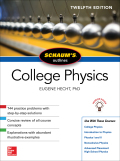
Concept explainers
An electron is accelerated from rest through a potential difference of 800 V. It then moves perpendicularly to a magnetic field of 30 G. Find the radius of its orbit and its orbital frequency.
The radius and orbital frequency of the electronthat is accelerated from rest through a potential difference of
Answer to Problem 35SP
Solution:
Explanation of Solution
Given data:
The electric potential difference is
The magnitude of the magnetic field acting on the electron is
Formula used:
The radius of a circular path of a charged particle moving along in a magnetic field is given as
Here,
The velocity of a charged particle moving due an electric potential difference is given as
Here,
The expression for orbital frequency of an object is given as
Here,
Explanation:
Consider the expression for radius of the circular path of an electron:
Here,
Consider the expression for the velocity of an electronmoving due to an electric potential difference:
From equation (1) and (2)
Keep in mind that
Substitute
Consider the expression for the velocity of an electron moving due to an electric potential difference:
Substitute
Consider the expression for the orbital frequency of the electron:
Here,
Substitute
Conclusion:
Therefore, the radius and the orbital frequency of the electron orbit are
Want to see more full solutions like this?
Chapter 30 Solutions
College Physics
- A proton precesses with a frequency p in the presence of a magnetic field. If the intensity of the magnetic field is doubled, what happens to the precessional frequency?arrow_forwardAn electron is accelerated through 2.40 103 V from rest and then enters a uniform 1.70-T magnetic field. What are (a) the maximum and (b) the minimum values of the magnetic force this particle experiences?arrow_forwardWhat magnetic field is required in order to confine a proton moving with a speed of 4.0 × 106 m/s to a circular orbit of radius 10 cm?arrow_forward
- Consider an electron rotating in a circular orbit of radius r. Show that the magnitudes of the magnetic dipole moment and the angular momentum L of the electron are related by: = L=e2marrow_forwardA mass spectrometer (Fig. 30.40, page 956) operates with a uniform magnetic field of 20.0 mT and an electric field of 4.00 103 V/m in the velocity selector. What is the radius of the semicircular path of a doubly ionized alpha particle (ma = 6.64 1027 kg)?arrow_forwardA particle of charge q and mass m is accelerated from rest through a potential difference V, after silica it encounters a uniform magnetic field B. If the particle moves in a plane perpendicular to B, shaft is the radius of its circular orbit?arrow_forward
- A long, straight, horizontal wire carries a left-to-right current of 20 A. If the wire is placed in a uniform magnetic field of magnitude 4.0105 T that is directed vertically downward, what is tire resultant magnitude of the magnetic field 20 cm above the wire? 20 cm below the wire?arrow_forwardAt a particular instant an electron is traveling west to east with a kinetic energy of 10 keV. Earth's magnetic field has a horizontal component of 1.8105 T north and a vertical component of 5.0105 T down. (a) What is the path of the election? (b) What is the radius of curvature of the path?arrow_forwardA proton (charge + e, mass mp), a deuteron (charge + e, mass 2mp), and an alpha particle (charge +2e, mass 4mp) are accelerated from rest through a common potential difference V. Each of the particles enters a uniform magnetic field B, with its velocity in a direction perpendicular to B. The proton moves in a circular path of radius rp. In terms of rp, determine (a) the radius rd of the circular orbit for the deuteron and (b) the radius ra for the alpha particle.arrow_forward
- Show that the magnetic field at a distance r from the axis of two circular parallel plates, produced by placing charge Q(t) on the plates is Bind=02rdQ(t)dtarrow_forwardCheck Your Understanding In what orientation would a magnetic dipole have to be to produce (a) a maximum torque in a magnetic field? (b) A maximum energy of the dipole?arrow_forwardAn alpha-particle ( m=6.641027kg , q=3.21019C ) travels in a circular path of radius 25 cm in a uniform magnetic field of magnitude 1.5 T. (a) What is the speed of the particle? (b) What is the kinetic energy in electron-volts? (c) Through what potential difference must the particle be accelerated in order to give it this kinetic energy?arrow_forward
 Glencoe Physics: Principles and Problems, Student...PhysicsISBN:9780078807213Author:Paul W. ZitzewitzPublisher:Glencoe/McGraw-Hill
Glencoe Physics: Principles and Problems, Student...PhysicsISBN:9780078807213Author:Paul W. ZitzewitzPublisher:Glencoe/McGraw-Hill
 Modern PhysicsPhysicsISBN:9781111794378Author:Raymond A. Serway, Clement J. Moses, Curt A. MoyerPublisher:Cengage Learning
Modern PhysicsPhysicsISBN:9781111794378Author:Raymond A. Serway, Clement J. Moses, Curt A. MoyerPublisher:Cengage Learning Principles of Physics: A Calculus-Based TextPhysicsISBN:9781133104261Author:Raymond A. Serway, John W. JewettPublisher:Cengage Learning
Principles of Physics: A Calculus-Based TextPhysicsISBN:9781133104261Author:Raymond A. Serway, John W. JewettPublisher:Cengage Learning Physics for Scientists and Engineers with Modern ...PhysicsISBN:9781337553292Author:Raymond A. Serway, John W. JewettPublisher:Cengage Learning
Physics for Scientists and Engineers with Modern ...PhysicsISBN:9781337553292Author:Raymond A. Serway, John W. JewettPublisher:Cengage Learning Physics for Scientists and EngineersPhysicsISBN:9781337553278Author:Raymond A. Serway, John W. JewettPublisher:Cengage Learning
Physics for Scientists and EngineersPhysicsISBN:9781337553278Author:Raymond A. Serway, John W. JewettPublisher:Cengage Learning





